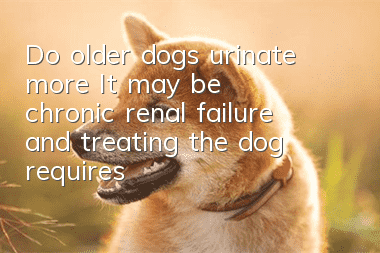Do older dogs urinate more? It may be chronic renal failure, and treating the dog requires two stages

It is estimated that one in 10 dogs will develop kidney disease in old age. Unlike humans, dogs only have one kidney. Once the kidney is damaged, the damage to the dog will be fatal. As age increases, the probability of elderly dogs suffering from chronic renal failure will also increase. After all, the cause of this disease is often related to aging. Once a dog is found to be suffering from this disease, the owner can also treat it in many ways to make the dog live longer.
1. Chronic renal failure in dogs
Chronic renal failure does not mean that the dog's kidneys completely stop working or stop urinating. This disease causes the dog's kidneys to be unable to effectively filter waste from the blood and excrete these wastes in the urine. Most older dogs with chronic renal failure will produce more urine, but this cannot promote the excretion of metabolic waste produced in the body.
2. Symptoms of chronic renal failure in dogs
As mentioned above, dogs with chronic renal failure need to excrete more urine to remove metabolic waste from the body, which also leads to symptoms of increased urination, thirst, and dehydration in dogs. As the disease progresses and two-thirds of the kidney tissue is destroyed, metabolic wastes in the dog's blood will gradually accumulate, leading to other physical diseases. Dogs with advanced chronic kidney failure may experience loss of appetite, depression, vomiting, diarrhea, bad breath, and sometimes canker sores.
3. How to treat chronic renal failure in dogs?
First of all, owners should understand that the treatment of chronic renal failure is a long process. If you find that your dog has the above symptoms, you should take it to the pet hospital for examination immediately. With early diagnosis and active treatment, elderly dogs can live normally for several years. Typically, treatment is divided into two phases.
1. The first stage of treatment
In the first stage, the pet doctor will inject a large dose of intravenous fluid into the dog, which can help flush the dog's kidneys and blood, remove toxic metabolic waste, and help mildly damaged kidney cells restore function. This process is called diuresis . At the same time, the first stage of treatment also requires a healthy diet to control the dog’s vomiting and diarrhea.
The first stage of treatment usually has two results. One is that the dog’s kidneys restore function and maintain this for weeks or even years. But as long as treatment is stopped, chronic renal failure will still relapse. The second is that the kidney function cannot be restored, and the dog can only continue the first stage of treatment.
2. The second stage of treatment
The second stage of a dog’s treatment is generally to allow its kidneys to continue working normally. The owner canOn the advice of your veterinarian, use one or a combination of the following treatments.
Use special dog food. Some nutritionists have developed special dog food specifically for dogs suffering from chronic renal failure. This kind of dog food generally contains low protein and phosphorus content, which can prevent dogs from vomiting and diarrhea and reduce the production of metabolic waste in the body. For dogs with chronic renal failure, reducing protein intake can reduce the burden on the kidneys.
Phosphate binder. Dogs with chronic kidney failure are often unable to excrete phosphorus from the blood, causing phosphorus levels to rise and causing the dog to become lethargic and have a loss of appetite. Some drugs can combine in the intestines to form phosphates so that they are not absorbed into the bloodstream and are instead excreted through the intestines.
Home fluid therapy. Fluid therapy is often used in the first phase of treatment, and in the second phase, owners can inject certain medications at home. However, owners must consult their pet doctor to learn about injection-related matters. Fluid therapy not only prevents your dog from becoming dehydrated but also continues to flush toxins from the blood. The specific frequency of injections needs to be determined according to the dog's condition. If the dog's condition is stable, the owner can reduce the number of injections.
Although chronic renal failure in elderly dogs cannot be cured, as long as they receive timely treatment and stabilize the development of the disease, dogs can still live for several years. Many dogs with this disease can live a happy old age with a normal standard of living if they receive proper treatment and care. And the most important thing is that no matter what serious illness the dog suffers from, I hope the owner can stay with it.
1. Rubin S I. Chronic renal failure and its management and nephrolithiasis[J]. Veterinary Clinics: Small Animal Practice, 1997, 27(6): 1331-1354.
2. Bartges J W. Chronic kidney disease in dogs and cats[J]. Veterinary Clinics: Small Animal Practice, 2012, 42(4): 669-692.
- How to train a dog to understand its own name when it has just arrived at a new home?
- Why do pet dogs lose hair?
- What's going on when a dog burps and vomits?
- Can a dog go out after being vaccinated?
- Symptoms and treatment of gastric distension in dogs
- What should I do if my pet dog is losing hair?
- How does a novice train an ancient shepherd dog to defecate? Two methods to easily train an ancient shepherd dog to defecate at a fixed location!
- What should I do if my dog disobeys me? 5 ways to train your dog at home!
- Dog internal deworming
- What's going on when a dog vomits blood?



